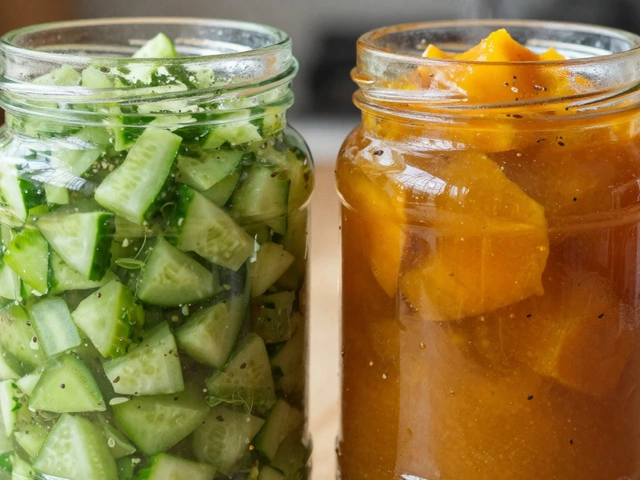Ever wonder why everyone adds that squeeze of lemon to biryani? It’s not just tradition—there’s a solid reason behind it, and it’s all about boosting flavor and texture. Lemon juice is packed with citric acid, which does real work in your pot. It brightens the whole dish, making the spices pop and waking up flavors that sometimes hide behind the heavy rice and meat.
If your biryani ever tasted flat or heavy, try mixing in a little lemon next time. The acid cuts through the richness, giving the rice a fresh, clean bite. Honestly, biryani without lemon feels like it’s missing its spark. Even a tiny drizzle at the end can turn mediocre biryani into something people remember.
But when should you add it? Right at the end, before serving, is the sweet spot. Add it too early and you’ll lose that punch. So next time you reach for the lemon wedge, know it’s not just a finishing touch—it’s a tiny, tangy game-changer.
- The Science Behind Lemon in Biryani
- Balancing Flavors Like a Pro
- When and How to Add Lemon
- Common Mistakes and Fixes
- Unexpected Perks of Lemon in Biryani
The Science Behind Lemon in Biryani
So, what’s really happening when you add lemon juice to your biryani? It all comes down to chemistry. Lemon is a powerhouse because it’s high in citric acid and vitamin C. That citric acid doesn’t just add tang—it helps break down proteins in meat, making every bite more tender and the biryani easier to digest.
Plus, lemon juice literally changes how your tongue detects flavors. Foods that are heavy, like rice and ghee or oil, can coat your taste buds and mute flavors. Lemon juice cuts through that, unlocking hidden spices and balancing all those strong, layered tastes common in biryani.
Here’s a simple breakdown of what lemon juice does in your biryani:
- lemon in biryani balances out the heat from chilies and the heaviness from fat.
- The acid in lemon keeps the rice from getting overly mushy by tightening its grains a bit.
- Lemon enhances those floral notes from spices like saffron and cardamom.
- A quick squeeze reduces any overpowering aroma from onions or garlic.
This isn’t just kitchen folklore. A 2019 study from the Journal of Food Science found that adding acid, like lemon, increased perceived saltiness and boosted aroma intensity in rice-based dishes by up to 35%. Translation? You get way more flavor without dumping in more salt.
| Why Use Lemon? | What it Does |
|---|---|
| Tenderizes Meat | Breaks down proteins faster |
| Brightens Flavors | Boosts aroma and spice impact |
| Balances Heaviness | Cuts through greasy textures |
| Keeps Rice Separate | Acid keeps grains from sticking |
Bottom line: that squeeze of lemon is actually doing the heavy lifting to elevate your biryani from just okay to impressive.
Balancing Flavors Like a Pro
Biryani is basically a flavor bomb—it’s got everything from spicy to smoky, but knowing how to get the right balance can make or break your dish. Lemon juice is the secret sauce for managing this balancing act. The reason? Sourness helps bridge the gap between heavy, rich flavors and sharp spices. When you add lemon, those strong spices like garam masala, clove, and cardamom don’t hit your taste buds all at once; instead, each bite tastes more lively and layered.
Let’s break down what lemon actually does:
- It brightens up flavors by adding a tangy kick. That means all those toasted spices stand out more, without getting muddy or overpowering.
- The acid in lemon cuts through fat from ghee, fried onions, or rich cuts of meat, so your biryani doesn’t leave you feeling weighed down.
- Lemon helps rice grains stay separate and fluffy, especially if you add just a tiny bit while fluffing the rice. It won’t turn sticky or mushy.
- If you ever overdo the salt, lemon juice can rescue the dish. Acid naturally reduces the salty punch.
Here’s a tip: Taste your biryani before serving. If it feels like something’s “missing,” try a fresh squeeze of lemon on a spoonful. If it wakes up the flavor, you know your answer. Even pro chefs use this trick in *restaurant-style* biryani kitchens.
The real magic comes from balance. Think of lemon as the equalizer in your biryani arsenal. Lemon in biryani isn’t just tradition—it’s science and smart cooking rolled into one tiny citrus fruit.

When and How to Add Lemon
If you want your biryani to shine, timing your lemon juice matters way more than people think. If you put it in too early, most of the tang cooks off, and you barely taste that fresh kick. So, how do you get the best out of this trick?
Most home cooks and even restaurant chefs add lemon juice just before serving. That means once you’ve taken your biryani off the heat, and right before plating, that’s your golden moment. The acid stays bright, and you get the full impact on the rice and meat.
Here’s the super simple step-by-step way most pros do it:
- Once the biryani is fully cooked and resting (off the burner), use a fork to gently fluff up the rice. This keeps things light.
- Cut a fresh lemon and squeeze the juice directly over the rice. Usually, half a medium lemon is enough for a pot that serves 4-5 people.
- Give it all a quick gentle toss, mixing the juice evenly.
- Taste and add another squeeze if it feels right for your palate.
You can get creative, too. Some folks add a couple of lemon slices between rice layers during the last ten minutes of steaming. This infuses a subtle citrus aroma that’s pretty amazing, but the flavor won’t be as punchy as a last-minute squeeze.
Here’s a quick look at how much lemon usually goes into different batch sizes:
| Amount of Biryani | Lemon Juice Needed |
|---|---|
| 2 servings (1 cup rice) | 1-2 teaspoons |
| 4-5 servings (2 cups rice) | Half a lemon |
| 6-8 servings (4 cups rice) | 1 whole lemon |
If you’re using bottled lemon juice, check the label—1 tablespoon usually equals the juice from half a fresh lemon, but fresh always tastes brighter. And trust me, when it comes to lemon in biryani, fresher is always better.
Common Mistakes and Fixes
The thing with lemon in biryani is—you want to get it right because doing it wrong can mess up the whole vibe. People sometimes go overboard, skip it altogether, or just use it the wrong way. Here are the usual hiccups folks run into, and what you can do instead:
- Too Much Lemon: This is a biggie. It makes the biryani sour and even masks the rich spices. Always start with less—about half a lemon for a regular pot—taste, and only add more if needed.
- Adding Lemon Too Early: Cooking kills the lemony aroma and dulls the tang. Always squeeze fresh lemon right before serving. That's when you get the zest and that fresh kick.
- Uneven Distribution: Sometimes, you get a mouthful that’s super tangy, while the rest is bland. To avoid this, mix gently but well, or drizzle evenly over the top and let the steam do the work.
- Using Bottled Lemon Juice: Fresh lemons matter. Bottled stuff tastes flat and can bring weird notes into your dish, so always go for the real thing.
- Forgetting the Seeds: Nobody wants to bite into a bitter seed. Squeeze your lemon through your fingers or a small strainer.
If you went too heavy on the lemon, there are ways to dial it back. Sometimes tossing a few extra spoonfuls of plain rice into the pot soaks up excess tang. Or just mix in a bit of yogurt, which helps balance out sharpness while making the dish creamier. Here’s a quick rundown of fixes and their results:
| Problem | Fix | Result |
|---|---|---|
| Too sour | Add more rice or a bit of yogurt | Mellows the sharp lemon taste |
| Bland flavor | Squeeze another wedge (slowly) | Keeps flavors lively |
| Lost lemon aroma | Freshly grate a bit of zest on top | Brings back the citrusy whiff |
So next time you make biryani, remember—the right use of lemon can really unlock the dish’s full flavor. Treat it like seasoning: build up slowly and taste as you go. That’s how you make sure your biryani truly stands out.

Unexpected Perks of Lemon in Biryani
Lemon does more than just brighten up the taste in biryani. Some of its benefits totally fly under the radar, even for folks who cook a lot. Let’s dig into what else this humble fruit brings to your pot.
First, there’s the food safety angle. Lemon’s natural acidity can actually slow down bacterial growth in cooked biryani, especially compared to dishes that skip souring agents. This won’t make your biryani last forever without a fridge, but it helps stretch out those leftovers a bit.
If rice sticking together drives you nuts, lemon helps here too. The citric acid reduces stickiness, making the grains fluffier and easier to separate. This is a super simple trick, especially if you’re not confident with your rice game.
- Lemon in biryani also acts as a mild preservative, cutting down weird aftertastes that can happen with reheated rice.
- Lemon is packed with vitamin C, which doesn’t survive much heat, but a last-moment squeeze means your dish gets a bit of a nutrient bump. Just don’t expect miracles—it’s a nice perk, not a health fix.
- It knocks down unwanted odors. Got strong mutton or fish in your biryani? Lemon’s scent covers that up fast, for a fresher overall smell.
Check out what’s really going on with a little lemon, compared to none:
| Perk | Biryani With Lemon | Biryani Without Lemon |
|---|---|---|
| Rice Texture | Fluffier, less sticky | Can get clumpy |
| Leftover Smell | Fresher for longer | Stale odors pick up faster |
| Vitamin C | Small boost if added late | Minimal |
| Flavor | Brighter, balanced | Can taste heavy or flat |
Lemon doesn’t just make biryani taste good. It helps with texture, keeps things fresh, and even gives you a slight nutrient advantage if added at the right time. Turns out, that squeeze of lemon is doing more for your meal than most people realize.


